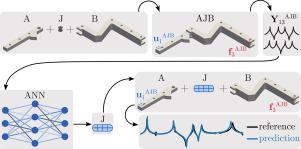Mechanical Systems and Signal Processing ( IF 8.4 ) Pub Date : 2023-05-18 , DOI: 10.1016/j.ymssp.2023.110426 Jure Korbar , Domen Ocepek , Gregor Čepon , Miha Boltežar

|
The dynamic properties of assembled structures are governed by the substructure dynamics as well as the dynamics of the joints that are part of the assembly. It can be challenging to describe the physical interactions within the joints analytically, as slight modifications, such as static preload, temperature, etc. can lead to significant changes in the assembly’s dynamic properties. Therefore, characterizing the dynamic properties of joints typically involves experimental testing and subsequent model updating. In this paper, a machine-learning-based approach to joint identification is proposed that utilizes a physics-based computational model of the joint. The idea is to combine the computational model of the joint with dynamic substructuring techniques to train the machine-learning model. The flexibility of dynamic substructuring permits the enforcement of compatibility and equilibrium conditions between the component models from the experimental and numerical domains, facilitating the development of machine-learning models that can predict the dynamic properties of joints. The proposed approach provides an accurate data-driven method for joint identification in real structures, while reducing the number of measurements needed for the identification. The approach permits the identification of a full 12-DoF joint, enabling the coupling of 3D dynamic models of substructures. Compared to the standard decoupling approach, no spurious peaks are present in the reconstructed assembly response. The proposed approach is validated numerically and experimentally by reconstructing the assembly response and comparing the results with known assembly dynamics.
中文翻译:

使用子结构化技术训练人工神经网络:在联合识别中的应用
组装结构的动态特性由子结构动力学以及作为组件一部分的接头的动力学决定。以分析方式描述接头内的物理相互作用可能具有挑战性,因为静态预载、温度等微小的修改可能会导致组件动态特性发生显着变化。因此,表征关节的动态特性通常涉及实验测试和后续模型更新。在本文中,提出了一种基于机器学习的关节识别方法,该方法利用关节的基于物理的计算模型。这个想法是将关节的计算模型与动态子结构技术相结合来训练机器学习模型。动态子结构的灵活性允许在实验和数值领域的组件模型之间实施兼容性和平衡条件,促进可以预测关节动态特性的机器学习模型的开发。所提出的方法为真实结构中的联合识别提供了一种准确的数据驱动方法,同时减少了识别所需的测量次数。该方法允许识别完整的 12 自由度关节,从而实现子结构的 3D 动态模型的耦合。与标准解耦方法相比,重建的装配响应中不存在虚假峰。



























 京公网安备 11010802027423号
京公网安备 11010802027423号